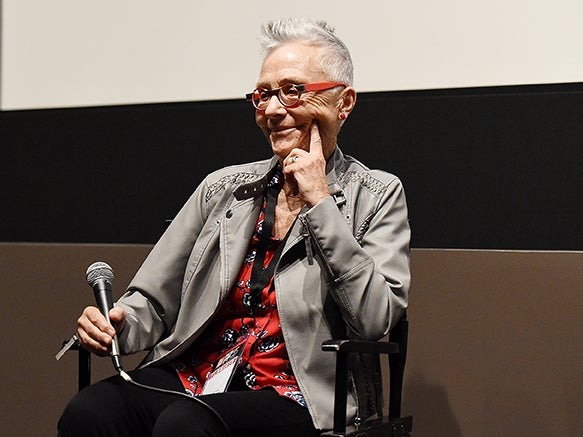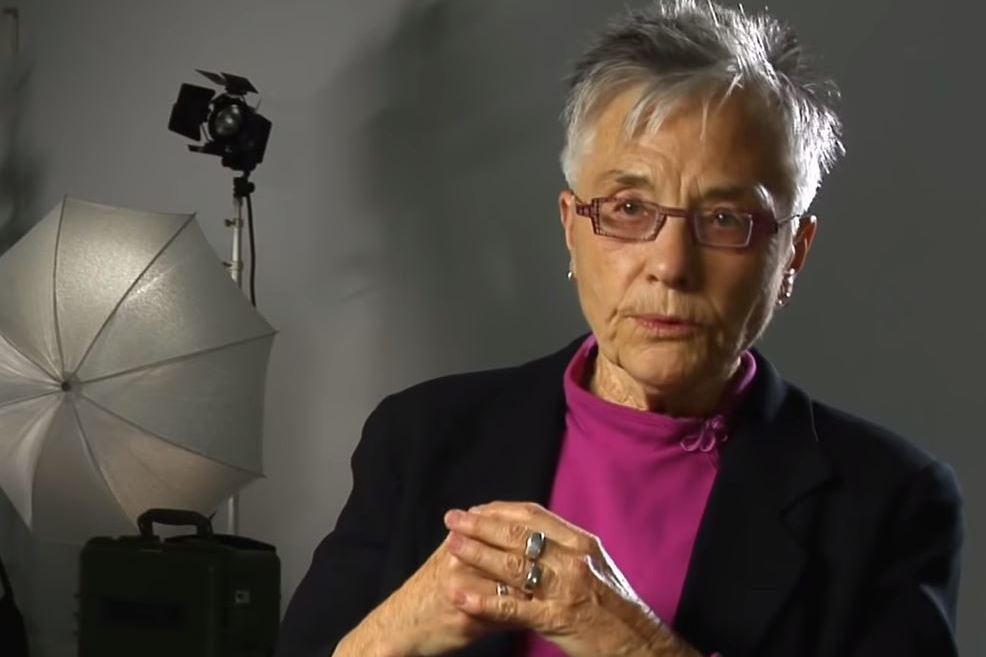Barbara Hammer: Artist and filmmaker who first brought authentic lesbian love to the screen
In later life, the feminist was diagnosed with cancer and inspired many by embracing dying as an art of living

Your support helps us to tell the story
From reproductive rights to climate change to Big Tech, The Independent is on the ground when the story is developing. Whether it's investigating the financials of Elon Musk's pro-Trump PAC or producing our latest documentary, 'The A Word', which shines a light on the American women fighting for reproductive rights, we know how important it is to parse out the facts from the messaging.
At such a critical moment in US history, we need reporters on the ground. Your donation allows us to keep sending journalists to speak to both sides of the story.
The Independent is trusted by Americans across the entire political spectrum. And unlike many other quality news outlets, we choose not to lock Americans out of our reporting and analysis with paywalls. We believe quality journalism should be available to everyone, paid for by those who can afford it.
Your support makes all the difference.Barbara Jean Hammer’s smile beams from her website; she is entangled with a reel of film and sporting a tank top that says “super dyke” – the title of one of her revolutionary films of the 1970s. The American lesbian feminist filmmaker, who has died aged 79 after living with cancer since 2006, leaves a fecund cultural record of experimental film, visual art, writing, performance, conversation and intervention that not only documents queer identities, communities, desires and realities but militates for their embrace.
In October, she delivered a performative lecture at New York’s Whitney Museum of American Art entitled, “The art of dying or (palliative art making in the age of anxiety)”. Reflecting on its success – she roused the audience to a standing ovation – she told Artforum magazine: “If anything I’d like to be a role model, I’d like to say, join me!”
Hammer is regarded as the most influential lesbian filmmaker of the 1970s and a radical force in art and society. In a career spanning five decades, she produced 80 moving-image works alone. Early 16mm shorts such as 1974’s Dyketactics, Multiple Orgasm (1976) and Superdyke Meets Madame X (1975), directed with Max Almy, she sought to “abolish lesbian invisibility” by presenting uncompromisingly lesbian performances of lesbian identity, intimacy, lovemaking and experience – women being and enjoying women – outside the male gaze and heterosexist discourse.
“It has been the goal of my life,” she once said, “to put a lesbian lifestyle on the screen. Why? Because when I started I couldn’t find any!” Knowing that this is still hard and precarious work, Hammer recently established a lesbian experimental filmmaking grant using the proceeds of the sale of her archive to Yale University. “I want this grant to make it easier for lesbians of today,” she explained. “So you can make work that you want to make.”
Throughout her career, Hammer experimented with a variety of avant-garde media and multi-modal styles to make work on themes ranging from the relationship between sight and touch (Sync Touch, 1981), media representations of LGBT+ people and Aids activism (Snow Job: The Media Hysteria of Aids, 1986), the endangering of ecosystems, species and the genre of experimental film itself (Endangered 1988), the intricacy and precarity of the human body (Sanctus, 1990; Dr. Watson’s X-Rays, 1991; Vital Signs 1991), menstruation (Menses 1974), marginalised lesbian and gay relationships and histories (Nitrate Kisses, 1992; History Lessons, 2000), the role of the artist in a time of war (Resisting Paradise, 2003), ageing, living with cancer and chemotherapy (8 in 8, 1994; A Horse is Not a Metaphor, 2009; Evidentiary Bodies, 2018) intergenerational solidarity in experimental art (Generations, 2010), and the lives of queer artists (Welcome to This House, 2015).
While each unique, her works have in common an abiding commitment to show what is present but unseen; to make lives and experiences that are rendered invisible within dominant frames visible; to show that social parameters of possibility cannot contain the multiplicity and fluidity of human being. In one of her final interviews, she described how cultures were becoming more accepting of personal identities, saying: “To live in a place where ‘we don’t take for granted’ – that’s my kind of living.” This impulse to live deliberately and make “real choices” beyond those that are dictated as necessary flowed through Hammer’s life.
Born in Los Angeles in 1939, she received a bachelor’s degree in psychology in 1961; two days later, she married her college boyfriend Clayton Ward. They travelled the world for a year on a Lambretta scooter, then built a house on six acres of land in Sonoma County where she had a horse and a studio and “was getting stuck in a housewife role” and reading about non-traditional artists’ lives. She left nine years later with nothing but her maiden name, experiencing a feminist awakening and later coming out as both a lesbian and an artist. She experimented with relationships and films for some years before meeting her partner of 31 years, human rights and anti-human-trafficking activist Florrie Burke. She said this relationship altered her approach to her life and work. She wanted, she said, “to find out what it’s like to take one person and go all the way. And that’s what I’ve been able to do thanks to both of us putting up with each other.”

Deeply committed to inspiring and mobilising cultural and social change, Hammer developed a passion for “activating” audiences by engaging them through touch and sensation, which are core to her lesbian aesthetic. “I see empathy as a way for us to come together from our diverse landscapes,” she said. Hammer strove to make films that would evoke it. Simultaneously presenting images from multiple vantages and scales, liberating film from its traditional rectangular frame, juxtaposing co-existing realities, asking audiences to move in order to see are all invitations to see, hear, feel and move outside the box; to “see other possibilities and to try something new ourselves”. Carrying this project from her earliest explorations of the youthful lesbian body through studies of ageing, illness and her own and others’ dying, as well as in her advocacy for engaged and dignified death, Hammer’s fidelity to the beauty of life in all its varieties was as much a form of “radical, life-affirming art” as was the work she produced.
In the ongoing exploration of Hammer’s trailblazing queer life and art and in the new experimental work that will be nurtured by the Barbara Hammer Grant (awarded in 2018 to New York-based filmmaker and visual artist Miatta Kawinzi), we have much to take courage from and be inspired by. Once describing time as an “energy field” rather than a straight line or circle, Hammer teaches us how to understand her own life as a resource of hope for living otherwise. “Time,” she said, “is an emotional muscle. If I can connect with my audience through images or editing structures that create emotions then they are there as physical bodies experiencing the film. They are released when the film turns meditative, and I hope then that they experience the world differently when they leave the cinema.”
Barbara Hammer, experimental visual artist and filmmaker, born 15 May 1939, died 16 March 2019
Join our commenting forum
Join thought-provoking conversations, follow other Independent readers and see their replies
Comments